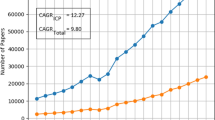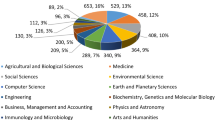Abstract
International cooperation has always been a popular subject in academic research. Recently, with the rise of “Author Contributions,” quantitative research using the authors' division of labor in scientific research has provided a new perspective for the measure of international cooperation. In this article, international collaboration is analyzed in a more fine-grained way, namely by considering the importance of contributions of different authors at the national level. Semantic structures of the division of labor are extracted via text mining from the author contribution sections of life sciences publications in the Nature Index’s 68 journals, are categorized with two predefined rule libraries into corresponding division categories. Then, quantitative analysis of the Chinese division of labor is conducted from the perspectives of both quantity and structure and at both the national and international levels. From the perspective of quantity, at both the national and international levels, Chinese contributions in any category of the division of labor have been increasing in the past 10 years, not only in proportion, but also in as ranked among other countries, especially in the category of experiment operation. From the structural perspective, China’s contributions have become more structurally balanced in the past decade. In 2017, China's structure of the division of labor was between those of BRICS countries and G7 countries. From the co-authorship perspective, the significant differences between China and other countries are reflected in both sample and data collection and tools and technology.





Similar content being viewed by others
References
Baerlocher, M. O., Newton, M., Gautam, T., et al. (2007). The meaning of author order in medical research. Journal of Investigative Medicine, 55(4), 174–180.
Basu, A., Foland, P., Holdridge, G., et al. (2018). China’s rising leadership in science and technology: Quantitative and qualitative indicators. Scientometrics, 117, 249–269.
Bates, T., Ani, A., Marusi, M., et al. (2004). Authorship criteria and disclosure of contributions: Comparison of 3 general medical journals with different author contribution forms. JAMA, 292(1), 86–88.
Braun, T., Glanzel, W., & Schubert, A. (1989). Assessing assessments of British science. Some facts and figures to accept or decline. Scientometrics, 15(3), 165–170.
Cheng, Y., Liu, Y., & Wang, W. (2015). Empirical research on international S&T cooperation promoting the annual conference of China Soft Science, Beijing.
Corrêa, E. A. Jr., Silva, F. N., Luciano, D. F. C., et al. (2017). Patterns of authors contribution in scientific manuscripts. Journal of Informetrics, 11(2), 498–510.
Feeser, V. R., & Simon, J. R. (2014). The ethical assignment of authorship in scientific publications: Issues and guidelines. Academic Emergency Medicine, 15(10), 963–969.
Glänzel, W. (2001). National characteristics in international scientific co-authorship relations. Scientometrics, 51(1), 69–115.
Glänzel, W., & Schubert, A. (2003). A new classification scheme of science fields and subfields designed for scientometric evaluation purposes. Scientometrics, 56(3), 357–367.
Glänzel, W., Schubert, A., & Czerwon, J. (1999a). An Item-by-item subject classification of papers published in multidisciplinary and general journals using reference analysis. Scientometrics, 44(3), 427–439.
Glänzel, W., Schubert, A., Schoepflin, U., & Czerwon, J. (1999b). An item-by-item subject classification of papers published in journals covered by the SSCI database using reference analysis. Scientometrics, 46(3), 431–441.
Graf, H., & Kalthaus, M. (2018). International research networks: Determinants of country embeddedness. Research Policy, 47(7), 1198–1214.
Han, T., & Cai, X. (2019). Analysis of division of labor in high quality life science research of China. In Proceedings of ISSI 2019—the 17th international conference on scientometrics and informetrics (pp. 1346–1357). Italy: Sapienza University of Rome.
Kozma, C., & Calero-Medina, C. (2019). The role of South African researchers in intercontinental collaboration. Scientometrics, 121(3), 1293–1321.
Larivière, V., Desrochers, N., Macaluso, B., et al. (2016). Contributorship and division of labor in knowledge production. Social Studies of Science, 46(3), 417–435.
Leydesdorff, L. (2008). On the normalization and visualization of author co-citation data: Salton’s Cosine versus the Jaccard Index. Journal of the American Society for Information Science and Technology, 59(1), 77–85.
Leydesdorff, L., Wagner, C. S., & Bornmann, L. (2014). The European Union, China, and the United States in the top-1% and top-10% layers of most-frequently cited publications: Competition and collaborations. Journal of Informetrics, 8(3), 606–617.
Paul-Hus, A., Mongeon, P., Sainte-Marie, M., et al. (2016). The sum of it all: Revealing collaboration patterns by combining authorship and acknowledgements. Journal of Informetrics, 11(1), 80–87.
Sauermann, H., & Haeussler, C. (2017). Authorship and contribution disclosures. Science Advances, 3(11), e1700404.
Shashnov, S., & Kotsemir, M. (2018). Research landscape of the BRICS countries: Current trends in research output, thematic structures of publications, and the relative influence of partners. Scientometrics, 117(2), 1115–1155.
Yang, S., Wolfram, D., & Wang, F. (2017). The relationship between the author byline and contribution lists: A comparison of three general medical journals. Scientometrics, 110(3), 1273–1296.
Yank, V. (1999). Disclosure of researcher contributions: A study of original research articles in the Lancet. Annals of internal medicine, 130(8), 661–670.
Zhang S. (2016). Research on optimization of author contribution weight algorithm, Ph.D. Dissertation. Beijing: University of Chinese Academy of Sciences.
Zhang, Z., Rollins, J. E., & Lipitakis, E. (2018). China’s emerging centrality in the contemporary international scientific collaboration network. Scientometrics, 116(2), 1075–1091.
Acknowledgements
The present study is an extended version of a paper (Hai and Cai 2019) presented at the 17th International Conference on Scientometrics and Informetrics, Rome, Italy, 2–5 September 2019. The authors would like to thank Henk F. Moed for his help and support with the conference. The authors would also like to thank our colleagues, Liying Yang, Yajuan Zhao, Junpeng Yuan, and Jielan Ding, from the National Science Library, Chinese Academy of Sciences, for their advice and suggestions and Mengge Sun for assistance with data collection.
Author information
Authors and Affiliations
Corresponding author
Rights and permissions
About this article
Cite this article
Cai, X., Han, T. Analysis of the division of labor in China’s high-quality life sciences research. Scientometrics 125, 1077–1094 (2020). https://doi.org/10.1007/s11192-020-03582-7
Received:
Published:
Issue Date:
DOI: https://doi.org/10.1007/s11192-020-03582-7




